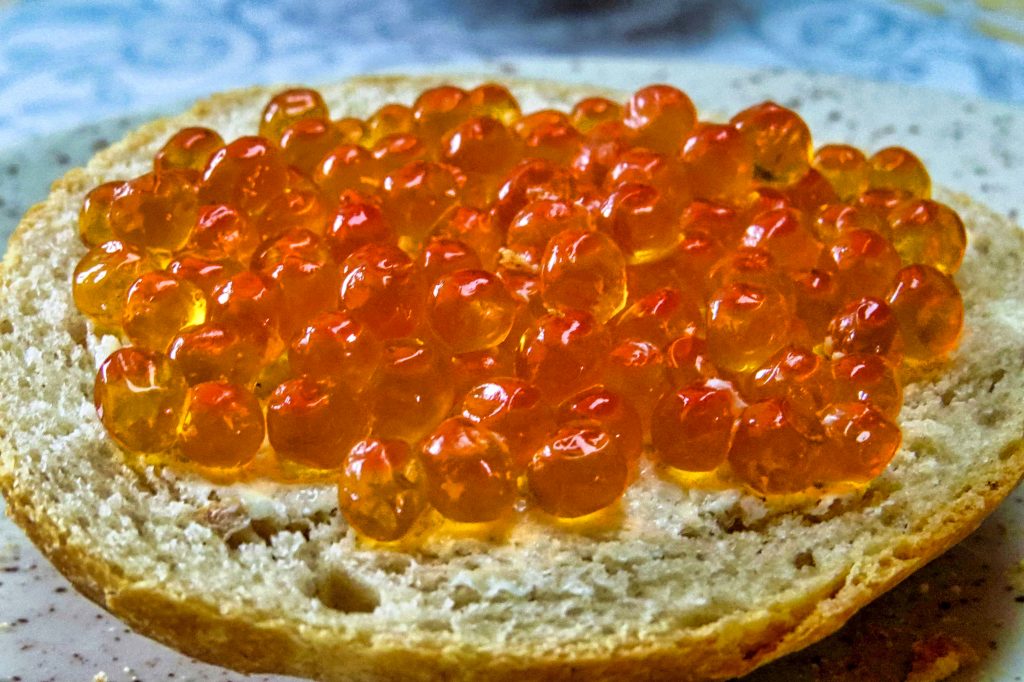A Dutch proverb says: “A country rich of herrings gets by with very few doctors.” The same applies to salmon: the omega-3 fatty acids contained in salmon are said to be very healthy for the body and to strengthen the immune system.
Getting access to high-quality salmon is anything but easy: if there is no sea nearby, going to the fisherman is usually not an option – so the only option is to go to the market and the supermarket. The variety of different types of salmon is immense and at first difficult to grasp for the salmon enthusiast.
Free-ranging salmon from the Atlantic and Pacific oceans have been a food source for humans for centuries.
Wild caught salmon and aqua farms
There are two major variations when it comes to salmon processing: Wild caught salmon and salmon from aquafarms. Salmon from aqua farms became available only a few decades ago, since that time when the demand for the fish made it impossible to meet the demand with wild caught salmon: Instead of controlling demand through price, the decision was made to make salmon available to the masses, thus lowering the price of the fish.
Free-ranging salmon from the Atlantic and Pacific oceans have been a food source for humans for centuries.
Along the Columbia River in North America, which flows into the Pacific Ocean, Native Americans are said to have had a special relationship with salmon as early as 12,000 years ago. The North American natives already appreciated the healthy effect of salmon meat on the human body.
The life of a salmon
A salmon is born in freshwater waters: After birth, the salmon swims to saltwater waters and spends most of its life there. Salmon are anadromous fish, which means that in order to reproduce, they return to freshwater. Often, they return to the very waters in which they were born.
Since rivers are freshwaters, rivers such as the Rhine or the Thames were home to numerous salmon just over 100 years ago: countless salmon returned there for the breeding season. With the onset of industrialization and the accompanying pollution of the rivers, the salmon retreated from these waters. Until the end of the 19th century, the Rhine was considered the best place in Europe to fish for salmon.
Today, finding a salmon in the Rhine is like a sensation.
Overfishing and last habitats
As fishermen around the world became more experienced and had better equipment, salmon became overfished: too few salmon returned to fresh waters to reproduce. Thus, many salmon populations were driven from their habitats.
One of the few remaining natural salmon habitats is in Alaska: it is home to wild-caught Pacific salmon. Salmon farms do not exist in Alaska.
But even the salmon industry does not function entirely without human influence: with the help of sound waves, fishermen lure salmon back into fresh waters during the salmon season so that they can reproduce there.
Wild salmon: caught wild, but not born wild
But even sound waves are not enough to preserve salmon populations: The term wild salmon usually refers to the fact that the salmon was wild caught. There is often no mention of whether the salmon was born without human influence.
Between 70 and 80 percent of wild salmon caught in the Pacific Northwest comes from hatcheries. These hatcheries raise salmon eggs and distribute them throughout the waters. Later, the adult salmon are wild caught.
If only wild-born and wild-caught salmon were used, the vast majority of people would be unaware of the salmon fish: not only would stocks be overfished to extinction, but the annual demand of several million tons of salmon could not be met merely with wild salmon.
In terms of quality and nutritional value, wild-caught salmon often ranks on top: the food a salmon finds in the wild sea differs significantly from the feed a salmon is fed in an aquafarm.

Different Species
Five species of wild Pacific salmon can be found in the North Pacific: the Chinook (king salmon), sockeye (red salmon), coho (silver salmon), humpback salmon, and chum salmon: most of these varieties are caught fresh in the Pacific in June and July. The fishing season continues until the end of September: During the period from June to September, fresh salmon can be obtained from fishermen. Throughout the rest of the year, salmon is available as frozen fish and canned. Fresh fish is perishable, so it is best to eat it shortly after purchasing the fish.
Farm raised salmon is often more popular than wild salmon because farm raised salmon is much more affordable: in addition, farm raised salmon is available in much larger quantities than wild salmon.
Filleting and salmon caviar
Filleting a salmon is an art in itself: there are numerous books and courses to learn how to fillet a salmon. One can either have the fish filleted by the fishmonger one trusts, or one can cut the salmon oneself.
Salmon is a delicacy not least because of its healthy effect on the human body: A culture of its own has developed over the centuries around the fishing, preparation and eating of salmon. It is impossible to imagine the world of fish without salmon; for many fish connoisseurs, salmon products are the epitome of delicate food. Salmon comes in all varieties: There are not only products of adult salmon. Salmon caviar, which is made from salmon eggs, is just one of many delicacies that are produced around the salmon fish.
Main source: Morgan, Diane: “Salmon: Everything You Need to Know”, 2016 Chronicle Books
Cover picture: © Simon von Ludwig

 Deutsch
Deutsch